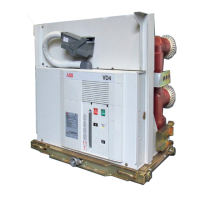2
1
Max 25 Nm
T1
Bare copper
– Clean with a fine file or emery cloth.
– Tighten fully and cover the contact surfaces with 5RX Moly type grease.
Copper or silver-plated aluminium
– Clean with a rough dry cloth.
– Only in the case of obstinate traces of oxidation, clean with a very fine
grain emery cloth taking care not to remove the surface layer.
– If necessary, restore the surface treatment .
Bare aluminium
– Clean with a metal brush or emery cloth.
– Cover the contact surfaces again immediately with neutral grease.
– Insert the copper-aluminium bimetal with surfaces shined (copper
side in contact with the terminal; aluminium side in contact with
the connection) between the aluminium connection and the copper
terminal.
T2
Bolt
Recommended tightening torque (1)
Without lubricant With lubricant (2)
M6 10 Nm 4.5 Nm
M8 30 Nm 10 Nm
M10 40 Nm 20 Nm
M12 70 Nm 40 Nm
M16 200 Nm 80 Nm
(1) The nominal tightening torque is based on a friction coeffcient of the thread of 0.14
(distributed value the thread is subjected to which, in some cases, is not negligible).
The nominal tightening torque with lubricant is according to the DIN 43673 Stan -
dards.
(2) Oil or grease. The thread and surfaces in contact with the lubricated heads.
Take into account the deviations from the general Standards table (for example, for
systems in contact or terminals) as foreseen in the specifc technical documentation.
The thread and surfaces in contact with the heads of bolts must be slightly oiled or
greased, so as to obtain a correct nominal tightening torque.
Racking-in
Racking-out
7.6. Power circuit connections of fixed circuit-breakers
7.6.1. General recommendations
– Select the cross-section of the conductors according to
the service current and the short-circuit current of the
installation.
– Prepare special pole insulators, near the terminals of the
fixed circuit-breaker or of the enclosure, sized according
to the electrodynamic forces deriving from the short-circuit
current of the installation.
7.6.2. Assembly of the connections
– Check that the contact surfaces of the connections are flat,
and are free of any burrs, traces of oxidation or deformation
caused by drilling or impacts received.
– According to the conductor material and the surface treat -
ment used, carry out the operations indicated in table T1 on
the contact surface of the conductor.
Assembly procedure
– Put the connections in contact with the circuit-breaker
terminals, taking care to avoid mechanical stresses (traction
/ compression) on, for example, the conducting busbars on
the terminals.
– Interpose a spring washer and a flat washer between the
head of the bolt and the connection.
– It is advisable to use bolts according to DIN class 8.8
Standards, also referring to what is indicated in table T2.
– In the case of cable connections, strictly follow the
manufacturer’s instructions to make the terminals.
Fig. 9
19

